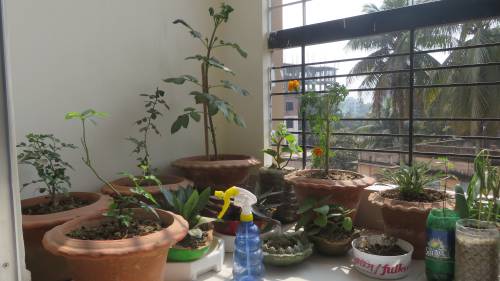
FAQ About Uses of Indoor No-Till Planting Systems

What is an indoor no-till planting system?
An indoor no-till planting system is a method of growing plants indoors without disturbing the soil structure between planting cycles. Instead of tilling or turning over the soil each season, organic matter is added to the top and allowed to decompose naturally, which maintains soil health and encourages beneficial microbial activity.

How does indoor no-till planting benefit soil health?
Indoor no-till planting systems benefit soil health by maintaining the soil's natural structure and preventing erosion. This method preserves the soil microbiome, allowing beneficial microorganisms to thrive. These microbes help in breaking down organic matter, releasing nutrients slowly over time, which is more sustainable compared to conventional tilling practices.

What are the labor-saving advantages of no-till systems?
No-till systems significantly reduce labor by eliminating the need for intensive soil preparation before each planting. There is no need for repeated digging and turning over of the soil, which saves time and physical effort. Additionally, the presence of mulch and cover crops helps suppress weeds naturally, decreasing the requirement for regular maintenance chores.

Can no-till planting be used for all types of indoor plants?
While no-till planting is highly beneficial for many types of indoor plants, particularly those that thrive in stable and nutrient-rich environments like fruits, vegetables, and certain herbs, it may not be suitable for every species. Plants with specific soil preference or shallow root systems may require modifications in traditional no-till approaches.

What materials are typically used to start a no-till system indoors?
Starting a no-till system indoors typically involves using organic materials such as compost, aged manure, leaf mold, and mulches. These materials are layered on top of the soil to mimic natural soil layers and provide a habitat for beneficial organisms. Crop residues and cover crops can also contribute to building a healthy no-till bed indoors.

Are there any environmental benefits of indoor no-till planting?
Yes, indoor no-till planting methods offer several environmental benefits. By maintaining soil structure, these systems reduce greenhouse gas emissions associated with soil disturbance. Additionally, they promote carbon sequestration as the soil stores more carbon when left undisturbed. Enhancing biodiversity by fostering a rich soil ecosystem is another critical environmental benefit.

How does no-till planting affect water retention in indoor gardens?
No-till planting enhances water retention in indoor gardens by preserving the soil structure and promoting organic matter accumulation. This results in improved soil porosity, which allows for better water infiltration and reduces runoff. Consequently, plants have more consistent access to water, which is particularly beneficial in indoor settings with controlled watering schedules.

Can pests and diseases be a problem in indoor no-till systems?
Pests and diseases can be a concern in any gardening system, but no-till methods can help mitigate these issues. A healthy soil microbiome enhances natural pest resistance by promoting beneficial predators and microorganisms. It's essential to monitor indoor gardens for signs of pests or diseases and use integrated pest management practices as needed. It is also beneficial to ensure that any materials introduced into the system, such as mulch or compost, are free of unwanted pests.

How is composting integrated into an indoor no-till planting system?
Composting plays a pivotal role in indoor no-till planting systems by providing a continuous supply of nutrients. Organic matter like kitchen scraps, coffee grounds, and plant residue is added directly onto the soil surface. Over time, these materials decompose, enriching the soil with nutrients and improving its texture. Integrating compost into the system eliminates the need for synthetic fertilizers, enhancing the sustainability of the garden.

Is no-till planting suitable for small indoor spaces?
No-till planting can be adapted for small indoor spaces through the use of containers, raised beds, or even vertical garden setups. The approach is flexible and can be tailored to fit various space constraints by adjusting the size and layout of the planting area. Techniques such as using dense planting and cover crops can enhance the efficiency of space use in smaller environments.

What types of cover crops are recommended for indoor no-till systems?
Cover crops that are recommended for indoor no-till systems include clover, rye, and vetch, as they enhance soil fertility and structure. These plants help fix nitrogen and provide biomass as they decompose, incorporating nutrients back into the soil. Their root systems can also improve soil aeration, which is beneficial for the overall health of the indoor garden system.

How can you prevent weeds in an indoor no-till garden?
To prevent weeds in an indoor no-till garden, mulch can be used to cover the soil surface, blocking light and suffocating weed seed germination. Additionally, incorporating dense planting arrangements and strategic crop rotation can outcompete weeds by maximizing space and nutrient use, leaving little room for undesired growth.

What is the role of microbial life in a no-till garden system?
Microbial life is central to the success of a no-till garden system. Microorganisms such as bacteria and fungi decompose organic matter, recycling nutrients back into the soil. They form symbiotic relationships with plant roots, which aid in nutrient absorption, disease resistance, and overall plant health. Maintaining a vibrant microbial community is crucial for the long-term sustainability of a no-till system.

Are there any specific requirements for transitioning from traditional to no-till gardening indoors?
Transitioning from traditional to no-till gardening indoors involves a few strategic adjustments. Start by gradually adding organic matter and mulch to the existing soil without disturbing it. Monitor and utilize beneficial organisms to improve soil health over time. It's important to manage pests and diseases naturally and avoid the use of synthetic inputs, which could disrupt the soil ecosystem.

Does indoor no-till planting influence the taste of homegrown produce?
Yes, indoor no-till planting can enhance the flavor and nutritional value of homegrown produce. The continuous recycling of organic matter in the soil provides plants with a diverse range of nutrients in a form they can readily uptake. Healthier soil typically leads to healthier plants, which often translates into more flavorful and nutrient-dense fruits and vegetables.

Can indoor no-till systems support perennial plants?
Indoor no-till systems can be very accommodating for perennial plants. The undisturbed soil promotes healthy root systems that encourage perennial growth and regeneration. With proper maintenance, such as the regular addition of mulch and compost, perennial plants can thrive and continue producing for several growing seasons.

What tools are typically needed for maintaining an indoor no-till garden?
Maintaining an indoor no-till garden requires minimal tools compared to conventional gardening. Useful items include a hand trowel for planting and harvesting, a watering can for irrigation, pruners for trimming excess growth, and possibly a compost bin if space allows for on-site composting. The focus is on minimizing soil disturbance, so heavy equipment is generally unnecessary.

How can soil compaction be avoided in an indoor no-till system?
To avoid soil compaction in an indoor no-till system, it's crucial to minimize walking or placing heavy objects over the soil surface. Regularly adding organic matter helps maintain soil porosity and structure. Additionally, plant roots, especially from cover crops, play a role in alleviating compaction by growing deep and creating channels that improve aeration.

What are common misconceptions about indoor no-till planting?
A common misconception is that indoor no-till planting requires no maintenance at all, whereas it still requires observation and support of healthy soil ecosystems. Another misconception is that it cannot support diverse plant types, which is not true as many varieties can adapt to this system with proper care. Finally, some believe no-till is only suitable for outdoor use when in fact, its principles apply equally well indoors.

How does indoor no-till planting compare to other sustainable gardening practices?
Indoor no-till planting compares favorably to other sustainable gardening practices by emphasizing minimal soil disturbance and natural nutrient recycling. Unlike hydroponics and aquaponics, which require technical systems and resources, no-till can be more accessible and require fewer artificial inputs. Its reliance on enhancing the natural soil ecosystem aligns with permaculture principles, making it a robust choice for sustainable indoor gardens.
